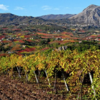Judging Tuscan Wines
We had just sat down to dinner on board the Corinithian II as it was leaving
The event was called the Vino VII Selezione
The tasting and judging took place in the Garden Hotel,
(www.gardenhotel.it) which is about a 25 minute walk from the Campo, in the center of
The event is held every two years. The wines included in the competition were D.O.C.G., D.O.C. and I.G.T. denominations from
Each of the nine panels of judges contained seven members: five enologists, one sommelier, and one journalist. Five of the journalists were non-Italians, representing
We evaluated the wines based on the method used by the Union International des Oenologues. We were given tasting sheets and told to write our panel number, the wine sample number, category, vintage, and whether the wine was White or Red. We had four minutes to evaluate each wine on the basis of Sight, Bouquet, Taste/Flavor. To do so, we circled numbers indicating a range from excellent to negative. Finally we had to add up our scores and put in a total. Once marked on the sheet, changes were not permitted. If necessary, you could do the whole sheet over but the organizers preferred to have your first impressions. If a wine was bad another bottle was poured, but now you had only two minutes between wines. Finally, there was a place for remarks and the sheets had to be signed.
 Giacomo Moretti of the Associazione Enologi e Enotecnici italiani
Giacomo Moretti of the Associazione Enologi e Enotecnici italiani
www.assoenologi.it was responsible for running the tasting. With a nod of his head the sommeliers would appear, show the judges the bottle with the number on it (so there would be no mistake), and pour the wine. If there was a bad bottle he would say “un altro bottlglia” and indicate the panel. This went like clockwork; even if someone dropped a glass or spilled the wine it was taken
care of efficiently. If a judge made a mistake on a tasting sheet it was Signor Moretti who came looking for you later.
The final score for each wine is a mathematical average eliminating both the highest and lowest scores. Luigi Prosperini, a lawyer, was responsible for the tasting sheets and calculating the scores. If a wine received at least 82/100 it was awarded with a Certificate of Merit, 85/100, a Certificate of Special Mention, and the first five wines in each category that obtained the highest number of points were awarded an Honorary Diploma.
I have never tasted so many wines with so little information and so quickly. It was a great experience and I learned a great deal. By the end of the tasting my mathematical skills had improved greatly.
The day before I was to leave for
For more information on the tasting and a list of the medal winners go to www.enoteca-italiana-it and www.toscanapromozione.it
Salvatore De Lio , manager of the Enoteca Italiana and Franco Ignesti from Toscana Promozione answered all of my questions and did a great job in organizing the tasting. ). Elena Boggiano, who organizes special events & promotions for the Enoteca Italiana, was of great help to me during and after the event supplying me with useful information.
I did not just taste wine while I was in
Signori Ignesti, Moretti, Prosperini, and De Lio took the foreign journalists to dinner. They could not have been nicer and we had long and interesting discussions on Italian wine and food. Il Mestolo dl Gaetano restaurant in
The second night we ate at the Enoteca Italiana in
The last night we ate at the Antica Osteria Divo, a few steps from the Duomo, Via Franciosa 29 (www.osteriadaivo.it). The young chef, Pino Di Cicco, served some very innovative appetizers. The highlight was the bistecca Fiorentine with boiled white beans in olive oil. The meat was cooked to perfection (I had the piece with the bone) and how I love the beans!
Michele wanted me to bring back an aged pecorino cheese and I looked all over





































i-Italy
Facebook
Google+
This work may not be reproduced, in whole or in part, without prior written permission.
Questo lavoro non può essere riprodotto, in tutto o in parte, senza permesso scritto.